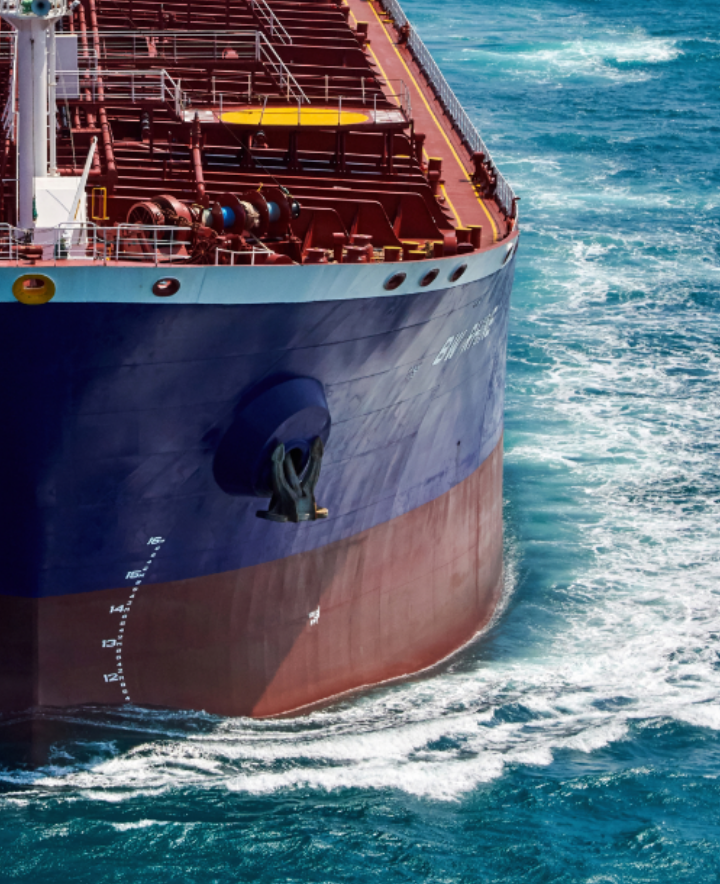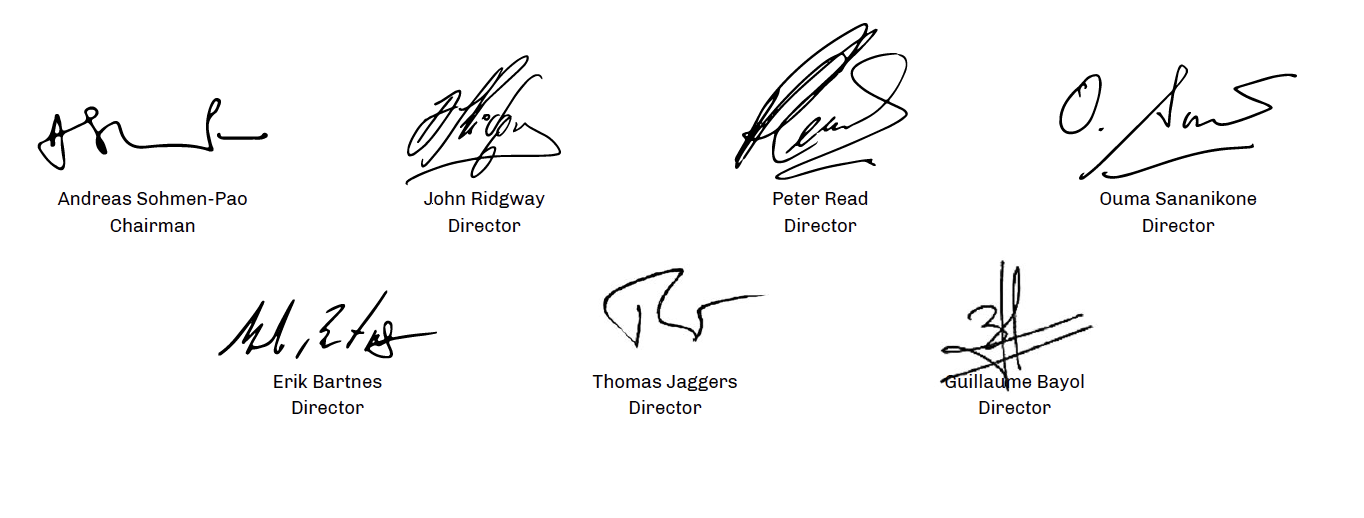11 | Board of Director’s report
Board of Directors’ report
As a modern shipowner, Hafnia Limited (the “Company” or “Hafnia”, together with its subsidiaries, the “Group”) aims to maintain flexible management of its business through integrated business units, which provides an understanding of the market dynamics through experience-based knowledge and enhanced insights into relevant developments and trends in all aspects of the product tanker industry. For further details about Hafnia, please refer to Section 2 in the 2021 Annual Report available on the company’s website www.hafniabw.com.
Financial performance
Time Charter Equivalent (TCE) earnings for Hafnia in 2021 decreased to USD 402.9 million from USD 623.2 million in 2020 due to weaker freight rates and higher voyage expenses, primarily attributed to rising bunker prices. Despite a challenging year, Hafnia reported TCE earnings of USD 10,353/day for its Handy fleet, USD 11,845/ day for its MR fleet, USD 10,952/day for its LR1 fleet and USD 23,382/day for its LR2 fleet. Hafnia’s net TCE in 2021 was USD 12,141/day based on a vessel utilisation of 98%, as compared to 2020, where net TCE was 18,090/day based on a vessel utilisation of 97%. Tanker markets experienced extremely challenging conditions throughout 2021, with an extended period of bottom-of-the-cycle level earnings since the second half of 2020.
Hafnia reported a net loss after tax of USD 55.5 million in 2021 as compared to a net profit after tax of USD 148.8 million in 2020, with a decline in ROIC and ROE to (0.4%) and (4.9%) respectively in 2021, from 8.9% and 13.1% respectively in 2020. The decrease in net profit after tax and returns in 2021 was mainly due to the lower TCE earnings.
Hafnia’s balance sheet remained strong throughout 2021, with total assets of USD 2,511.0 million, total liabilities of USD 1,398.9 million and total equity of USD 1,112.0 million amounting to an equity ratio of 44.3%, as compared to total assets of USD 2,543.9 million, total liabilities of USD 1,395.9 million and total equity of USD 1,148.0 million amounting to an equity ratio of 45.1% in 2020.
In 2021, Hafnia has invested in various digitalisation initiatives, namely Smartship, a cloud-based solution that collects live data from vessels and provides real time analytics, and has also partnered with Diginex, a leading sustainability-focused Impact Tech company, to bolster the digital collection, management, and reporting of Hafnia’s ESG data. Hafnia also invested in a joint venture with Andromeda Shipholdings Ltd, in which the joint venture currently owns two MR vessels.
Hafnia has signed a USD 100 million unsecured facility, with proceeds from the facility being used to optimise the pools’ working capital requirements and improving cash flows for pool participants. Hafnia has refinanced its existing USD 676 million and USD 128 million facilities to the USD 374 million facility; and refinanced its USD 266 million facility to the USD 84 million and USD 106 million facilities. In January 2022, Hafnia signed a term sheet to amend its USD 216 million facility. Through these transactions, Hafnia has secured up to USD 135 million of extra liquidity, through a combination of term loans and asset-based revolving credit facilities, allowing for extra flexibility in the balance sheet.
Hafnia’s cash flows for the year mainly comprise of cash from Hafnia’s operations, investing cash flows for the year comprise mainly of investments in the joint venture with Andromeda and the purchase of property, plant and equipment while financing cash flows comprise mainly of the proceeds from the new facilities and the repayments of loans and interest.
At the end of 2021, Hafnia had 84 owned vessels and 18 chartered-in vessels. The total fleet of the Group comprises of 102, vessels hereunder six LR2s, 12 Handy vessels, 33 LR1s1 (including four bareboat chartered-in and five time chartered-in) and 51 MRs2 (including nine time chartered-in).
In January 2022, Hafnia completed the acquisition of Chemical Tankers Inc (“CTI”) and its subsidiaries, which included CTI’s fleet of 32 fuel-efficient IMO II tankers. CTI’s shareholders received a total of 99,199,394 shares in Hafnia as consideration, representing 21.5% of the outstanding shares in the combined entity.
In January 2022, Hafnia entered into an agreement to purchase 12 LR1 vessels from Scorpio Tankers Inc (“STI”) for a total consideration of USD 413.8 million. The vessels are fully financed through a sale and leaseback arrangement with ICBC Financial Leasing Co., Ltd.. Hafnia has taken delivery of six vessels in March 2022, with the remaining six vessels expected to be delivered by May 2022.
In March 2022, Hafnia entered into an agreement for an en bloc sale of eight stainless steel vessels out of the CTI fleet acquired to an external party (the “Transaction”) for a total consideration of US$252.4 million. Four of the vessels are currently financed by sale and leaseback facilities and the remaining four vessels are financed by operating leases with call options. The Transaction remains subject to lenders consent. The vessels are planned to be delivered from the Group to the external party as soon as practically possible, by 30 September 2022, except for “Hafnia Spark” and “Hafnia Stellar”, which are expected to be delivered in September 2023.
1 Including six LR1s owned through 50% ownership in the Vista Joint Venture
2 Including one MR owned through 50% ownership in the Andromeda Joint Venture

Parent Company Accounts
Hafnia Limited is a holding company. The Company reported a net profit of USD 41.8 million for 2021, compared to a net profit of USD 89.8 million in 2020. The reduction in profit in 2021 is due to lower dividend income from its subsidiaries. Expenses of the company mainly comprise administrative expenses and costs related to the operations of the investment holding company as a listed entity.
Total assets were USD 1,288.6 million as of 31 December 2021 compared to USD 1,661.1 million in 2020. The decrease was mainly due to the liquidation of one of the Company’s subsidiaries. Total liabilities were USD 79.9 million as of 31 December 2021 compared to USD 497.4 million in 2020. The decrease was mainly due to a decrease in the Company’s related party payables resulting from the liquidation of one of the Company’s subsidiaries.
Total shareholders equity in Hafnia Limited is USD 1,208.7 million as of 31 December 2021 as compared to USD 1,163.7 million as of 31 December 2020.
Safety
Safety is a fundamental priority at Hafnia, and the Board is conscious that safety performance is a continuous process. Hafnia has programmes to cultivate and emphasize a “Zero Harm” safety culture on shore and at sea. For an overview of employee health and safety metrics, please visit here.
Risk management
Hafnia’s results are dependent on the market for worldwide transportation of refined oil products. Hafnia’s activities expose the company to a variety of financial risks: market risk (including price risk and currency risk), interest rate risk, credit risk, liquidity risk and capital risk. Hafnia’s overall risk management strategy focuses on the unpredictability of financial markets and seeks to minimise potential adverse effects on Hafnia’s financial performance. In addition, Hafnia is exposed to various market, operational, and financial risks. The most significant risks are set out in the latest prospectus issued by Hafnia on 1 March 2022 in connection with the CTI transaction. These documents and other information on risks are available on the company’s website at www.hafniabw.com.
The Group’s results are largely dependent on the worldwide market for transportation of refined oil products. Market conditions for shipping activities are typically volatile and, as a consequence, the results may vary considerably from year to year. The market in broad terms is dependent upon two factors: the supply of vessels and the demand for oil products. The supply of vessels depends on the number of newbuilds entering the market, the demolition of older tonnage and legislation that limits the use of older vessels or sets new standards for vessels used in specific trades. The demand side depends mainly on developments in global economic activity. The Group is also exposed to risk in respect of fuel oil costs. Fuel oil prices are affected by the global political and economic environment. For voyage contracts, the current fuel costs are priced into the contracts. Other risks that Management takes into account are interest rate risk, credit risk, liquidity risk and capital risk.
The Ukraine and Russia conflict, Covid-19 pandemic and the current downward pressure on global economic growth, and volatility in oil prices could have a significant adverse impact on the Group’s performance or operation.
Hafnia has also purchased and maintains a Directors and Officers Liability Insurance issued by a reputable, specialised insurer with appropriate rating.
Environmental, Social and Governance (ESG)
Environmental
In line with the increasing expectations of stakeholders and society – and because we know it is the right thing to do – Hafnia is committed to its role as a responsible industry leader. Throughout 2021, we have consolidated our material issues and the strategic direction of our ESG efforts. The path towards decarbonisation requires wide-reaching partnerships with internal and external stakeholders, including shipyards, charters, bunker suppliers and regulatory bodies. Regular communication with these parties is essential in informing our approach to sustainability and the development of solutions for net zero carbon shipping.
Hafnia’s ESG reporting includes progress and performance in the context of activities relating to environmental, social and governance considerations for the financial year ended 31 December 2021. For an overview of Hafnia’s ESG strategy, please visit here.
Social
A sustainable business is also dependent on social aspects. For Hafnia, our social strategy relates to our people employed both at sea and ashore. First and foremost, Hafnia strives to offer a physically and psychologically safe working environment. This means a work environment where our employees can be themselves and speak up. On top of this, we also aim to foster an environment where our employees can develop, learn and strive to become better versions of themself.
Gender inequality and being a female in shipping remains a significant challenge for both Hafnia and the wider shipping industry. At Hafnia, this issue is high on our agenda. It is already among our strategic priorities that we continually monitor salary ratios between men and women to eliminate differences in pay, but it is crucial that we foster an environment where all of our employees feel safe and valued both at sea and ashore. For an overview of the social impacts, please visit here.
Governance
Governance Hafnia stands against corruption and bribery in the maritime industry with a policy of zero tolerance for maritime corruption and bribery. Our focus is on the implementation of good governance and effective risk management processes. One of many ways Hafnia seeks uphold human rights and stop bribery and corruption is through our whistleblowing policy. This report provides an overview of how the Company has implemented sound corporate governance throughout its organisation. The Company’s corporate governance policies are based on the Norwegian Code of Practice for Corporate Governance (the “Code”) dated 14 October 2021 issued by the Norwegian Corporate Governance Board. The Code is available at www.nues.no. For an overview of the Company’s compliance with the Code, please visit here.
Going concern
In light of Hafnia’s liquidity position, balance sheet strength, assets, employment, and continuing cash flow from operations, the Board confirms that the going concern assumption, upon which Hafnia’s accounts are prepared, continues to apply.
Responsibility statement
We confirm that, to the best of our knowledge, the financial statements for the year 1 January to 31 December 2021 have been prepared in accordance with current applicable accounting standards, and give a true and fair view of the assets, liabilities, financial position and profit or loss of the Group and the Company taken as a whole. We also confirm that the Board of Directors’ Report includes a true and fair view of the development and performance of the business and the position of the Group and the Company, together with a description of the principal risks and uncertainties facing the Group and the Company.
